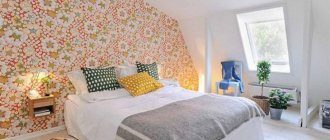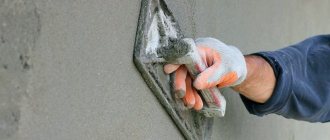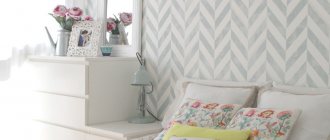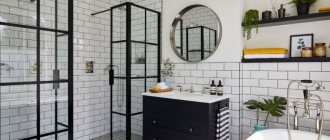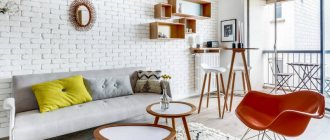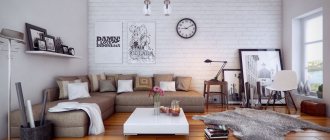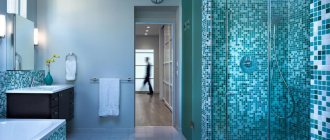Wall tiles are a special cladding coating that is used both for residential interiors and for furnishing industrial buildings. For a long time, tiles have been used not only for cladding the walls of bathrooms. The choice of tiled varieties of tiles for wall cladding allows you to realize the designers' ideas. In order to say which tiles on the wall will look good and convey the main meaning of the design idea, it is necessary to take a closer look at the question of what types of tiles for walls exist.
Advantages and disadvantages
Ceramic tiles have many advantages:
| Advantages of use | Disadvantages of use |
| Rich in variety, the collections allow you to fit tiles into any style of living room. | Tile is a cold material and, if you do not install a heated floor system, it will be uncomfortable to be in such a living room. |
| Durable material will withstand any load. | The slippery surface of glossy tiles is dangerous; such products are not recommended for use in a home where there are children or elderly people. |
| The tiles are fireproof, so they are suitable for facing fireplaces. | Relatively high cost. |
| Ceramic products are easy to clean from dirt. | For high-quality cladding, it is better to invite specialists. |
Hallway tiles
When selecting material for the hallway, you need to take into account that such rooms are the dirtiest and dustiest in the house. For this reason, this finishing material must be washed. At the same time, such a coating is subject to increased demands regarding resistance to wear and dirt absorption.
When decorating the walls with ceramic tiles in the hallway, you need to pay attention to the overall harmony of this finishing material and the style of the interior. In this way, you can create a truly beautiful hallway that will delight the owner of the house.
What tiles can be used in the hall?
Let's consider the types of products that are suitable for finishing the floor and walls in the living room:
- Tile/ceramic tiles. Consists of a mixture of clay, sand and minerals. During the production process, it is fired and covered with glaze, thanks to which you can obtain any pattern on the surface and any texture. The most popular option.
- Porcelain tiles. Ceramics pressed with granite chips. It has exceptional strength and resistance to high temperatures. A variety of designs is also achieved by glazing the surface.
- Plaster. Eco-friendly material for high-quality imitation of brick or stone masonry on the walls of the living room. It is light in weight and comes in a wide range of colors. Disadvantages: fragility of the material, instability to moisture and a textured surface that accumulates dust.
- Clinker room. It is considered an improved type of ceramics, as it has a more complex composition. Thanks to prolonged firing and pressing, strong, wear-resistant products of various shapes are obtained. Convenient to install.
The photo shows a living room in neutral colors, where the TV area imitates a marble surface. This decoration decorates the room and attracts attention.
Tips for laying tiles
The process of laying tiles on a wall requires the master to have knowledge and adherence to certain technical nuances:
- Before directly laying ceramic tiles on the wall, they should be carefully checked for defects and uneven edges. To obtain smoother seams, it is recommended to pre-sort the existing tiles;
- The surface of the wall before laying is carefully prepared and primed;
- It is recommended to frame all external corners with special plastic or metal corners;
- Each element of ceramic wall covering should be laid only on a dry surface.
If these rules are followed, the laid tiles will remain securely on the wall for many years.
Before laying tiles, it is recommended to study information regarding the quality of the tile adhesive that will be used when finishing the wall.
What can be tiled in the living room?
Based on their functional purpose, they distinguish between floor, wall and decorative tiles.
Floor
Due to high traffic, the living room floor covering must be resistant to damage. For safe movement, an anti-slip matte or rough texture is required. If the living room is combined with a dining room, the products should be easy to clean from dirt.
The photo shows a stylish living room with an unusual tiled floor. Shades of red brighten up neutral interiors.
Wall
For convenient cladding, wall tiles have a reduced weight. A fashionable trend is to decorate the wall in the form of a panel. Natural stone looks colorful in the living room interior.
Niche
Cladding a niche with ceramics is an original idea, as a result of which the wall in this area looks very impressive.
Fireplace
Due to their fire resistance, tiles are an ideal option for facing a fireplace. In addition, it transfers heat well and thereby increases its efficiency.
The photo shows a cozy cottage in a rustic style. A fireplace with bright decor adds a special touch to the interior.
Arch
Covering an opening with tiles imitating stone or brick can be called a classic. This is one of the most popular options for decorating an arch.
The photo shows a spacious living room that opens into a kitchen with an arch lined with rectangular tiles.
Material selection criteria
The facing material for finishing must be waterproof and easily withstand temperature changes. Facade tiles should differ significantly from tiles for interior work, and this is always taken into account by the manufacturer. A very important factor in strength is the coefficient of linear expansion of the material from which it is made.
If it is too high, the tile will not withstand winter frosts and summer heat, since strong expansion or contraction will deteriorate the layer of adhesive on which it is laid , and, as a result, the façade design will fall. Different types of facade materials are made using different technologies and from different materials.
The most important criterion for choosing a facing material is the purpose of the room. Do not use the same tiles for cladding different rooms, not to mention decorating facades. Therefore, the first question that needs to be answered clearly is: what performance characteristics should the material have, taking into account the conditions of a particular room?
For wet areas
Obviously, the bathroom and kitchen are rooms with high humidity, so gypsum tiles or hygroscopic rocks are not suitable for their cladding. In addition, in the kitchen there is a constant danger of contact with active substances such as fat, oil, organic acids, which should also be taken into account when choosing tiles.
For high-traffic areas
To tile a place with high mechanical loads, such as the floor of a staircase or hallway, you need to choose tiles made from durable materials, such as porcelain ceramics or natural volcanic stone . And only frost-resistant materials with increased resistance to aggressive atmospheric influences are suitable for external cladding.
Neglecting to analyze the operating conditions of the shell is often associated with the risk of its rapid destruction, even if the tile you choose has high technical characteristics. Do not use tiles with operating parameters that are unnecessary. In this case, you risk throwing away money by paying for unnecessary functionality. Frost-resistant tiles for a heated room are excessive expenses, as are waterproof tiles for a living room.
When choosing a flooring material, you must be guided not only by beauty, but also by practicality, because you must walk on it. The flooring material in the hallway should be more durable than the flooring in the bathroom.
Finally, consider the question, is there a matching tile for the chosen room? Despite the undoubted advantages from beauty to simple maintenance , a ceramic or stone substrate is hardly suitable for a bedroom or children's room: it has no warmth and will not bring comfort. However, this material is more suitable for those rooms where we do not spend too much time.
Color palette
Since the range of ceramic coatings on the modern market is wide, the choice of color scheme in the living room depends only on the taste of its owner.
- For connoisseurs of bright interiors, white, gray, beige tiles for floors and walls are suitable.
- Black color makes the space heavier, and it is also an impractical solution for the floor, since dirt and damage are clearly visible on it.
Today, manufacturers offer companion materials for wall decoration: pre-selected shades and patterns will help to professionally transform the interior of the living room.
The photo shows a bright living room with bright color accents. The “heavy” beamed ceiling is successfully compensated by the white floor.
Terracotta flooring is suitable for a country house: such a floor looks natural and cozy.
Tiles in rich colors - yellow, red, green - will become a bright accent in the interior. To avoid it being overloaded, the rest of the decor should be selected in neutral colors.
Briefly about the main thing
For the production of clinker tiles, only environmentally friendly raw materials are used. The working mass is passed through an extruder and subjected to heat treatment for several days.
The material with a small number of pores breathes and is not afraid of thermal changes and fire. It has low water absorption, high density and resistance to mechanical stress and cleaning with household detergents.
The cladding lasts for several decades.
The material can be used to decorate facades, plinths, paths and walls with ceilings, countertops with window sills in any room.
Ratings 0
Tile layout examples
The most common type of tile is square. It can be laid in the classic way (“seam to seam”) or diagonally. Products of various sizes and patterns are successfully combined. To create an unusual effect on the floor, tiles of the same shade are placed with a border instead of a plinth. Long rectangular products are usually laid “staggered” in imitation of natural materials: wood or brick.
The photo shows an interior where several types of tiles are combined. Figured and mirrored decorate the walls. Glossy porcelain tiles frame the contrasting wooden floor.
Glass cladding
Glass products look very aesthetically pleasing.
Such decorative tiles for interior decoration are made from glass waste and various additives. It can be blue, white, yellow, green, beige or blue.
Dimensions of glass elements:
- 30×30;
- 20×20;
- 15x15 cm.
Kitchen apron made of glass tiles.
Material thickness 8 mm. Its front side can be glossy or matte. On the working side of the slabs there are bulges 2 mm high.
- In wet rooms, glass cladding is glued to a polymer-cement mortar.
- Material of large dimensions is mounted with plastic glue. Three-dimensional tiles can also be secured with screws screwed into wooden choppers.
Glass can become deformed when exposed to sunlight and high temperatures. Therefore, it is not advisable to use tiles made from it for exterior facade decoration, near heating radiators or stoves.
Advantages of the material:
- Increased hardness.
- Increased strength.
Tile design
The varied shapes, textures and shades of ceramic coatings allow the apartment owner to decorate the living room in any way.
To expand the space of the room and give it airiness, the walls are decorated with mirror tiles. The wood-effect covering will add a touch of naturalness and comfort to the decor. You can also combine tiles with laminate by cutting out a curly line and covering it with an elastic threshold. “Marbled” products look great in the interior of the hall. To imitate carpeting, patterns with ornaments are used.
The photo shows an airy living room with sky-colored details. Mirror tiles emphasize the lightness of the decor and visually add space.
Connoisseurs of country style will love the cladding option in the form of panels made of combined tiles of different colors. This technique is called patchwork.
The shape of tiles today is the most diverse - designers offer not only squares and rectangles, but also rhombuses, honeycomb-shaped polyhedrons, and shaped products with rounded elements.
Using stone-like tiles, you can decorate the walls of the living room (either completely or partially), border windows, columns and doorways. Mosaic is suitable for facing fireplaces, as well as decorating walls: it is recommended to place it in inserts so as not to overload the space.
Kitchen-living room tiling ideas
If the apartment has a living room combined with a kitchen, tiled flooring will suit perfectly. A standard practical option is a kitchen apron. Recently, the rectangular “hog” has gained popularity: it looks advantageous in any style.
The photo shows a kitchen-living room, decorated with hexagonal “honeycombs” in pastel colors. They protect not only the walls, acting as an apron, but also the floor.
Porcelain tile flooring in the kitchen area is a good idea for practical people. Wear-resistant porcelain tiles will not wear out, absorb moisture and grease, or deteriorate under the influence of cleaning agents. Also, in a large room, zoning can be easily done using tiles.
In the photo there is a kitchen-living room, the division of zones occurs by combining floor tiles of different colors and shapes.
Self-cladding indoors
Installing ceramic tiles on walls, although not an easy task, often performed by experienced craftsmen, is also possible for home craftsmen. When performing this rather complex work, you need to be careful and attentive . Good and high-quality laying of tiles begins on a flat surface, the laying of the material is carried out without any distortion or chipping. If the tiles are laid along the entire perimeter of the room, then it is necessary that the spaces between the tiles where the work began coincide with the spaces on the opposite side at the end of the work.
Selection of tools
Before you start, you need to choose a building material and take a tool. For professional styling you need the following:
- putty knife;
- tile cutter;
- ruler;
- level;
- rubber hammer;
- glue.
Stages of work execution
The quality of work is mainly determined by the surface of the base on which the installation will be done. If there were already old tiles on the walls, then they need to be removed. The surface of the wall must be ideal: without protrusions and cracks. The slope of the surface should not exceed 3−4 mm . Everything is checked by level. Otherwise, it is necessary to level the surface with a primer.
Work order:
- The soil is also applied to areas with the greatest slope.
- Work needs to be checked for level.
- After preparing the surface, lay the first layer using a level, maintaining the required thickness under the lath, level and strengthen the tiles. You need to do this operation with all the walls. Some craftsmen mark walls with stretched ropes. This is done in order to obtain more even rows of tiles.
Thus, you can quickly lay out a horizontal or vertical row, inserting special crosses to maintain the size of the spaces. The width of the gaps between the tiles should be in the range from 2 to 4 mm. While laying tiles, it is recommended to periodically check the work level.
At the end of installation, you need enough time to dry the glue, then remove the crosses, clean the surface and seams from dirt and make a grout solution for the seams. After grouting, you need to wash all the walls.
Photos of the living room in various styles
The tiles in the living room will fit well into the modern style. It is characterized by minimalism and clear lines. For the living room, a monochromatic covering without pronounced patterns is suitable, which will serve as a backdrop for an advantageous display of furniture and accessories.
The classical direction is the complete opposite of the modern. Classic interiors are replete with decorative details. For finishing, materials are suitable that will emphasize the nobility and tranquility of this style: light colors, patterns, marbled imitation. For the floor, a good solution would be a coating that imitates dark parquet.
French Provence is popular with people seeking home comfort. Ceramics with stone and wood textures, as well as floral patterns or sketches of rural life, will help serve these purposes.
Loft-style tiles are widely used: imitation brickwork has become the hallmark of this trend. Large ceramic rectangles in gray colors look original and convincingly imitate a wall made of concrete blocks.
High-tech is characterized by functional design details and geometric shapes. Its main idea is the reflection of modern technologies in the interior. Rounded furniture and spotlights in combination with mirrored wall coverings will be an excellent solution for this style. A 3D tile with a three-dimensional multidimensional pattern will fit well.
The photo shows a loft-style attic, boldly combining tiles with both a pattern and imitation brick.


